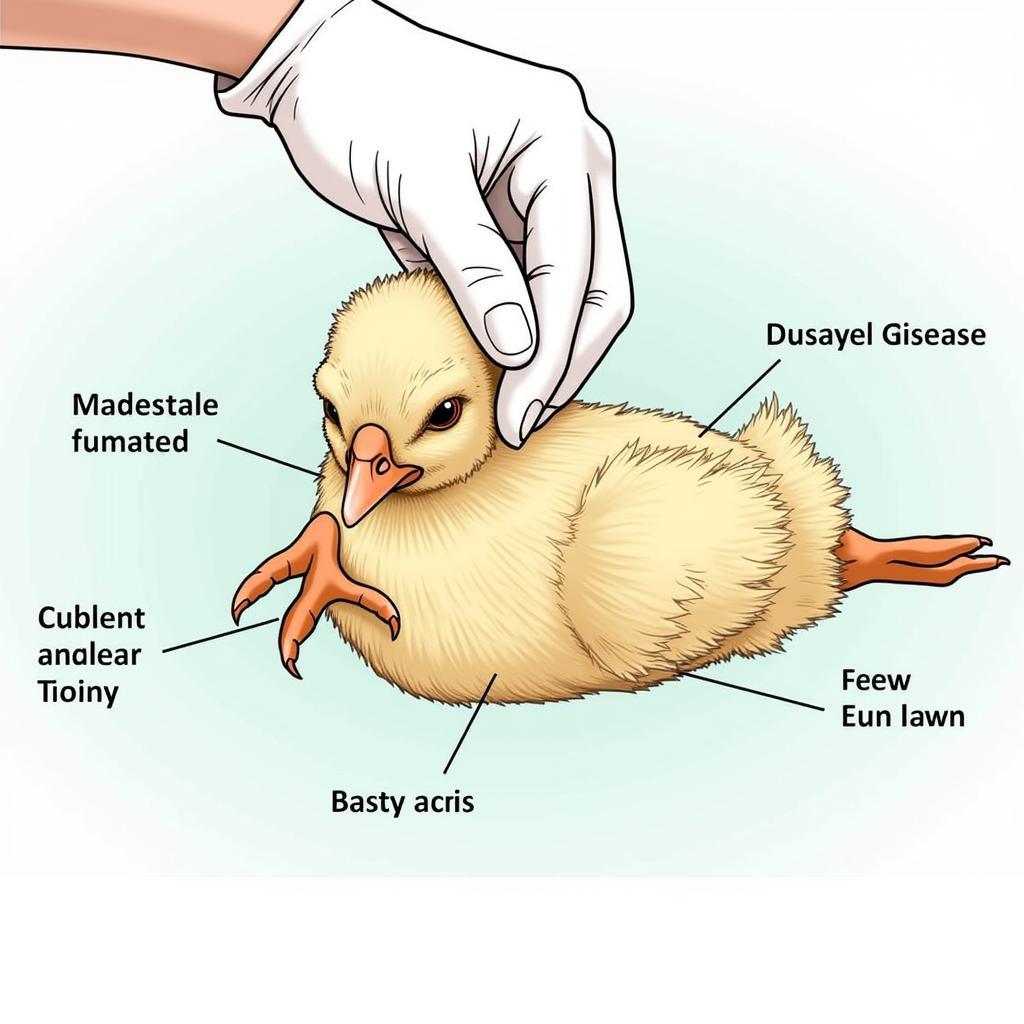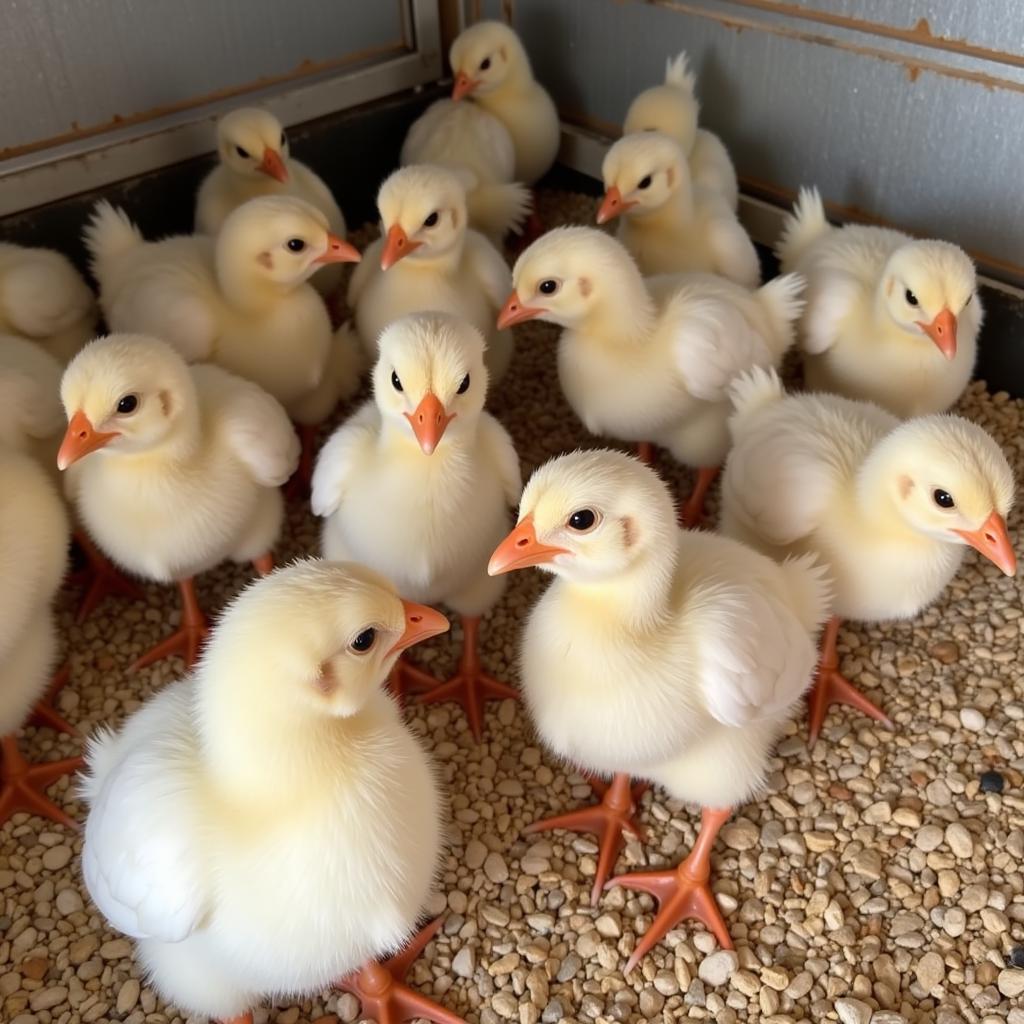Losing chicks one by one is a heartbreaking experience for any poultry keeper. If you’re asking yourself, “Why Are My Chicks Dying One By One?”, this guide is designed to help you understand the potential causes and offer solutions to prevent further losses. We’ll cover everything from common diseases to environmental factors and management practices that can impact chick survival.
Identifying the Culprit: Common Causes of Chick Mortality
Several factors can contribute to chick mortality. Pinpointing the exact cause can be challenging, but understanding the possibilities is the first step towards finding a solution.
Disease: The Silent Killer
Diseases are a significant threat to young chicks, especially those with underdeveloped immune systems. Some common diseases include:
- Coccidiosis: This parasitic disease affects the intestinal tract, causing diarrhea, weight loss, and eventually death.
- Salmonella: This bacterial infection can lead to various symptoms, including diarrhea, lethargy, and respiratory issues.
- Marek’s Disease: A highly contagious viral disease that can cause paralysis, tumors, and death.
- Infectious Bursal Disease (Gumboro): This viral disease targets the immune system, making chicks susceptible to other infections.
Environmental Factors: Creating a Safe Haven
The environment plays a crucial role in chick health. Factors like temperature, ventilation, and brooding conditions can significantly impact their survival.
- Temperature Fluctuations: Chicks are highly susceptible to temperature changes. Both overheating and chilling can be fatal.
- Poor Ventilation: Insufficient ventilation can lead to a buildup of ammonia and other harmful gases, causing respiratory problems.
- Overcrowding: Crowded conditions can increase stress, competition for food and water, and the spread of disease.
Management Practices: Nurturing Your Flock
Proper management practices are essential for raising healthy chicks. Neglecting basic needs can lead to increased mortality.
- Nutrition: Providing a balanced diet formulated specifically for chicks is crucial for their growth and development.
- Water Management: Clean, fresh water should always be available. Dirty water can harbor bacteria and parasites.
- Hygiene and Biosecurity: Maintaining a clean and sanitary environment can prevent the spread of disease.
Diagnosing the Problem: What to Look For
Identifying the specific cause of chick death requires careful observation. Here are some key things to look for:
- Symptoms: Note any unusual behavior, such as lethargy, diarrhea, respiratory distress, or paralysis.
- Post-Mortem Examination: If possible, examine a deceased chick for any internal or external abnormalities.
- Brooder Conditions: Check the temperature, ventilation, and humidity levels in the brooder.
- Feed and Water: Examine the quality and availability of feed and water.
Asking the Right Questions
When troubleshooting chick mortality, asking yourself the right questions can help narrow down the potential causes. For instance:
- What are the chicks’ symptoms? This helps identify potential diseases.
- What is the temperature and humidity in the brooder? This helps determine if environmental factors are at play.
- What are the chicks eating and drinking? This helps assess nutritional deficiencies or contaminated water sources.
- How old are the chicks? Certain diseases are more prevalent at specific ages.
 Performing a Chick Autopsy
Performing a Chick Autopsy
Implementing Solutions: Saving Your Flock
Once you’ve identified the potential cause of chick mortality, you can take steps to address the problem and prevent further losses.
Treating Diseases
If disease is suspected, consult a veterinarian for diagnosis and treatment recommendations. Some common treatments include antibiotics, antiparasitics, and supportive care.
Optimizing the Environment
Maintaining a comfortable and healthy environment is crucial for chick survival. Ensure proper temperature, ventilation, and humidity levels. Avoid overcrowding and provide adequate space for the chicks to move around.
Improving Management Practices
Implementing good management practices can significantly reduce chick mortality. Provide a balanced diet, clean fresh water, and maintain a clean and sanitary environment.
“Proper brooding management, including temperature control and sanitation, is the cornerstone of preventing chick mortality,” says Dr. Emily Carter, DVM, a poultry specialist with over 20 years of experience.
Why Are My Chicks Dying One By One? FAQs
1. How can I prevent coccidiosis in my chicks? Coccidiosis can be prevented through good sanitation practices and the use of coccidiostats in feed.
2. What is the ideal brooding temperature for chicks? The ideal brooding temperature starts at 95°F and gradually decreases by 5°F per week until the chicks are fully feathered.
3. How often should I clean the brooder? The brooder should be cleaned regularly, removing droppings and soiled bedding daily. A deep clean should be performed weekly.
 Healthy Chicks in a Brooder
Healthy Chicks in a Brooder
Conclusion: Ensuring a Thriving Flock
Losing chicks is a difficult experience, but understanding the potential causes and implementing appropriate solutions can help you prevent further losses and raise a healthy, thriving flock. Remember, addressing “why are my chicks dying one by one” starts with careful observation, proper diagnosis, and proactive management.
For any further assistance, please contact us at Phone Number: 0902476650, Email: [email protected] Or visit our address: 139 Đ. Võ Văn Kiệt, Hoà Long, Bà Rịa, Bà Rịa – Vũng Tàu, Việt Nam. We have a 24/7 customer support team.





